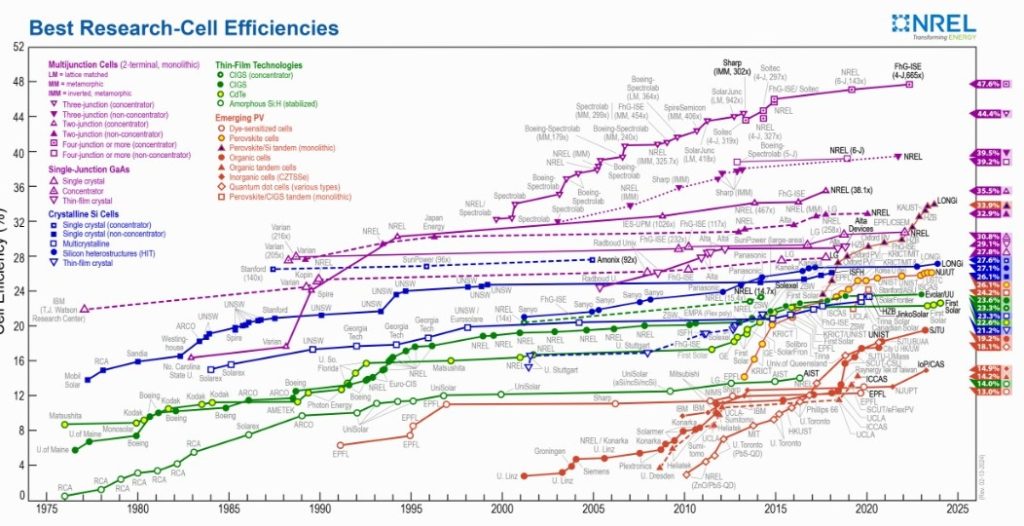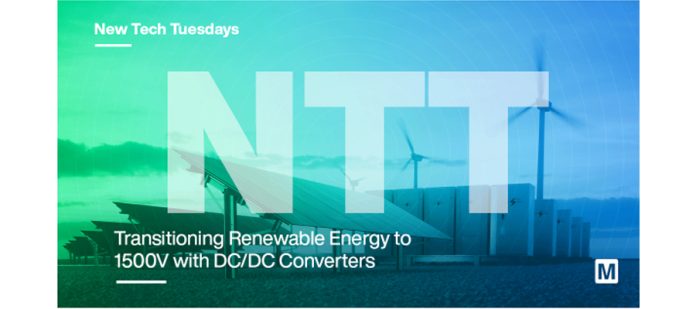Join Rudy Ramos for a weekly look at all things interesting, new, and noteworthy for design engineers.
The global renewable energy market has been experiencing substantial growth, driven by the increasing demand for clean and sustainable energy sources. Solar energy, in particular, has gained prominence as a key player in the renewable energy landscape. According to a report by Mordor Intelligence, the renewable energy market has now reached pre-pandemic levels, signifying its resilience and continued growth. This growth is attributed to various factors, including government incentives, technological advancements, and an increased awareness of environmental concerns.
The industry is constantly evolving to further enhance the efficiency and financial viability of photovoltaic (PV) systems. One critical aspect of this evolution is the need for 1500VDC PV systems. However, this transition presents challenges for DC-DC converters in supporting higher voltages. This week, we explore the progression and recent challenges of PV systems and consider how the solar market stands to benefit significantly from the AE15B-EW and AE15B-UW DC-DC converters from CUI Inc.
The Evolution of Photovoltaic Systems
To remain competitive and sustainable, photovoltaic systems must continuously improve their efficiency and financial viability. This drive for improvement stems from several considerations.
First, maximizing energy output. Efficiency is fundamental in solar energy generation. By increasing the efficiency of PV systems, more energy can be harnessed from the same amount of sunlight. This leads to higher energy production and better returns on investment. Facilities like the National Renewable Energy Laboratory (NREL), part of the US Department of Energy, regularly conduct testing of PV cells (Figure 1) and modules to ensure consistency and accuracy of PV performance metrics.

Second, reducing the installation costs. Financial viability is a crucial aspect of any solar project. Lowering installation costs, such as hardware and labor, can make solar energy more affordable for consumers and businesses alike. This is essential for the widespread adoption of solar technology.
Lastly, adapting to new technologies. The solar industry must continually adapt to emerging technologies, such as advanced materials and improved manufacturing processes. These innovations contribute to both increased efficiency and reduced costs.
The Need for 1500VDC Photovoltaic Systems
One significant development in the solar industry is the transition from traditional 1000VDC PV systems to 1500VDC PV systems. This increase in voltage has several advantages. Primarily, it improves the overall energy transmission. Stepping up to higher voltage systems allows for efficient electricity transmission over longer distances. This is particularly beneficial for large-scale solar installations and solar farms. Increasing the voltage also helps to mitigate electrical losses during energy transmission, resulting in less energy waste, thereby contributing to higher overall system efficiency. Also, 1500VDC systems require fewer electrical components, such as cables and connectors, leading to cost savings during installation and maintenance.
Challenges for DC-DC Converters in 1500VDC Systems
While the transition to 1500VDC PV systems offers numerous benefits, it also presents challenges for DC-DC converters, which play a critical role in these systems. For instance, DC-DC converters must be capable of handling the increased voltage levels in 1500VDC systems. This requires robust and reliable components to ensure safety and system stability.
Also, system efficiency is critical. Maintaining high efficiency levels in DC-DC converters is essential to maximize the energy harvested from solar panels. Any loss in efficiency can impact the overall performance of the PV system. Lastly, solar installations often operate in harsh environments with temperature variations and exposure to the elements, meaning DC-DC converters must be rugged and reliable to withstand these conditions over an extended period.
The Newest Products for Your Newest Designs
In the face of these challenges posed by the transition to 1500VDC PV systems, CUI Inc. offers solutions that help shape the future of renewable energy.
CUI Inc.’s AE15B-EW and AE15B-UW DC-DC converters (Figure 2) are 15W isolated modules designed for 1500VDC PV systems. These DC-DC converters are engineered to address the high voltage challenges while ensuring safety and reliability while delivering cost savings. Likewise, efficiency is a key focus, with the AE series boasting high efficiency levels to minimize energy losses and maximize solar energy output. These converters are rugged and reliable, built to endure remote outdoor solar installations and harsh environmental conditions, ensuring the longevity of PV 11 systems.

Available in board, chassis, and DIN rail mounting options, the AE series features power ratings from 5W to 40W. They excel in renewable energy applications, including solar power equipment, wind turbines, and electric charging stations. With an ultra-wide input voltage range of 200 to 1500VDC, input ratio ranges of up to 10:1, and robust 5600VDC input-to-output isolation, these modules are suitable for various setups.
The AE series is rated for operation at altitudes of up to 5000 meters and can withstand temperatures from -40°C to +70°C at full load, making them ideal for remote, high-altitude environments. Continuous over-current, over-voltage, and short-circuit protection with automatic recovery further enhance system reliability.
Tuesday’s Takeaway
As the renewable and solar energy markets continue to grow globally, the need for innovative solutions becomes increasingly apparent. Photovoltaic systems must evolve to maximize energy output, reduce costs, and adapt to new technologies. Hence, the transition to 1500VDC PV systems offers numerous benefits, including improved energy transmission, reduced electrical losses, and lower installation costs. However, this shift presents challenges for DC-DC converters in handling higher voltages while maintaining efficiency and reliability.
CUI Inc.’s AE series of DC-DC converters excel in addressing these challenges, offering high voltage handling, enhanced efficiency, and robust durability, making them an ideal choice for solar applications. These converters play a pivotal role in unlocking the full potential of renewable energy.

